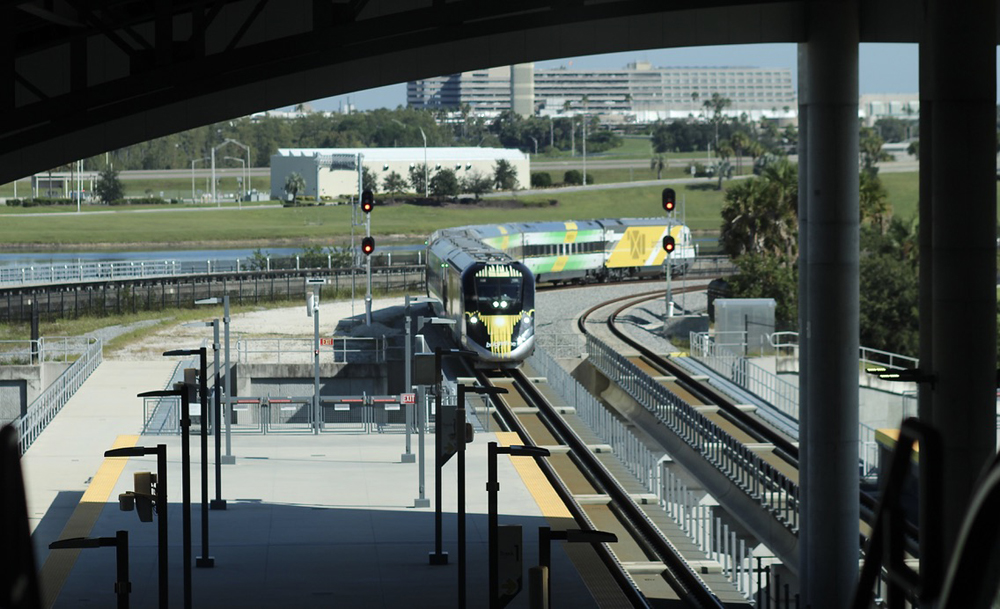
ORLANDO—Last week’s hoopla is over. So how is Brightline executing its Orlando-Miami service and how is it being received by passengers? Trains News Wire booked a “Smart” class seat on Saturday morning, Sept. 23, from Orlando to West Palm Beach to find out.
Vibrant airport venue
You knew the experience had begun to evolve from its Miami-West Palm roots when the jammed baggage kiosk lines at Orlando International Airport’s train station included a guy seeking to check a surf board. The 10:54 a.m. departure for Miami was sold out, and the preponderance of overnight travelers had lots of luggage to check. Brightline had anticipated the surge, so managers were ready to offer assistance before passengers reached the counter.
Given the relatively small luggage compartment at one end of the third “Smart” coach, I wondered how all those bags and odd pieces could be accommodated.
“Going to West Palm? The checked bag fee is $25 per bag, so why don’t you just carry it on?” I was pleasantly urged by the counter agent; I’m sure she was thinking the same thing.
Once through security — a Brightline obligation from the beginning — it was showtime. Dark overhead beams in the high-ceilinged room held focused lighting normally found in theaters.
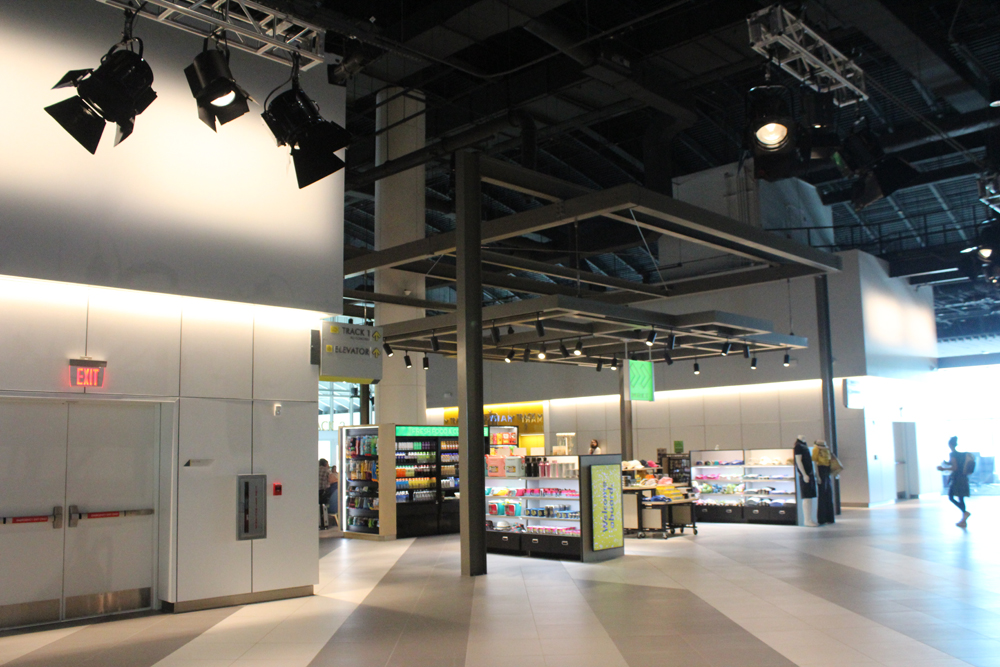
“Brightline President Patrick Goddard made it clear to us early on that he didn’t want Orlando to look like a typical train station, [but instead wanted] something more on the line of a hotel and unique to the community,” architect Jorge Borrelli told News Wire back in May. He and Brad Pascarella, who leads Matern Engineering, worked with Big Time Design to execute Goddard’s vision. “This is Orlando, home of the theme park,” added Pascarella, “so the station looks different than Brightline’s South Florida designs. The trick was to feature the stage lighting on the visible beams but hide necessary ductwork and conduit with what Disney calls “go away black.”
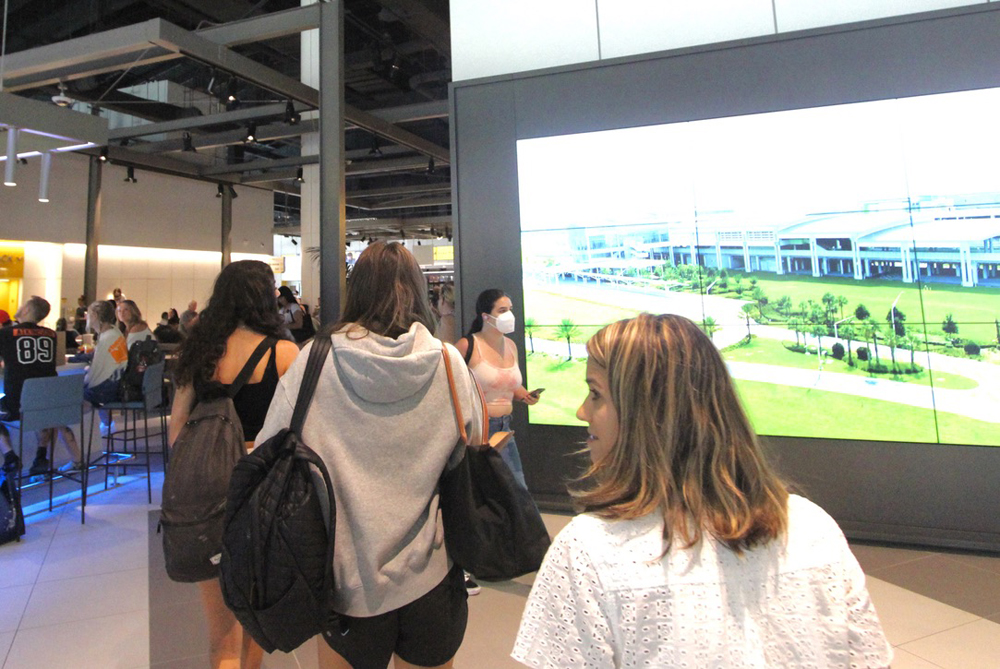
Were Goddard and his design team successful? Look closely at the face of the woman in the foreground arriving on BrightGreen from Miami that morning. The expression of engaged amusement is not generally seen on customers getting off North American trains. Mission accomplished.
Busy and smooth
The computer had picked an aisle seat to West Palm; no windows were available. Fares to that destination on the weekend were $119 to $169 in “Smart” and $229 to $269 in “Premium” on trains that weren’t sold out.
The luggage tower at one end of the coach was filled with large suitcases and the clear overhead luggage racks took up the slack but there was no sloppy overflow — often the case on Amtrak long-distance coaches.
However, once we departed and with no stops for an hour and a half, I saw one side of a table in Coach 2 was unoccupied. Cyndi and Lee Mueller had migrated to the other side when they were given separate seats during a similar last-minute booking.
“We were supposed to fly from Orlando to Zurich, Switzerland, via a connection in Philadelphia, but American Airlines told us the weather there was horrible and we would likely miss the plane,” Cyndi explained. “They did have two seats on Swissair out of Miami if we could get there, so here we are!
Even at the higher fares, Brightline was the most cost-effective option. The couple lives in The Villages, a self-contained community northwest of Orlando, and work remotely in separate insurance and medical supply businesses.
As BrightGreen began accelerating away from the airport, Lee Mueller marveled at how smooth the track was. “Really? 125?” he said, when I showed him the iPhone speedometer, but the proof was also outside the window as we effortlessly passed cars on the parallel Beachline Expressway.
One glitch surfaced when none of us could get sustained Wi-Fi on the east-west segment; cell phone service was also spotty. The “No internet access” error message was displayed until after the train made the big turn at Cocoa, Fla., and headed south. It’s not clear if there is a temporary coverage problem in the area. Brightline is utilizing Elon Musk’s Starlink satellite technology because it touts a higher bandwidth. When coverage returned, the Wi-Fi signal remained stable and didn’t require constant reconnection, as Amtrak’s system usually does.
Food for purchase in “Smart”
Well-trained and congenial onboard service crews have always been Brightline’s strong suit, and the personnel manning the food cart on BrightGreen Saturday were no exception.
Food and beverage is included in the Premium class fare; in Smart, you pay for everything, including coffee and bottled water. A small cup of premium Lavazza coffee is $3.25 and I added a $1 tip for servers James Lee Emanuel and Tyra Lee (so many “Lees”). This is certainly comparable to restaurant rates, though airline coach passengers are accustomed to having complimentary beverages.
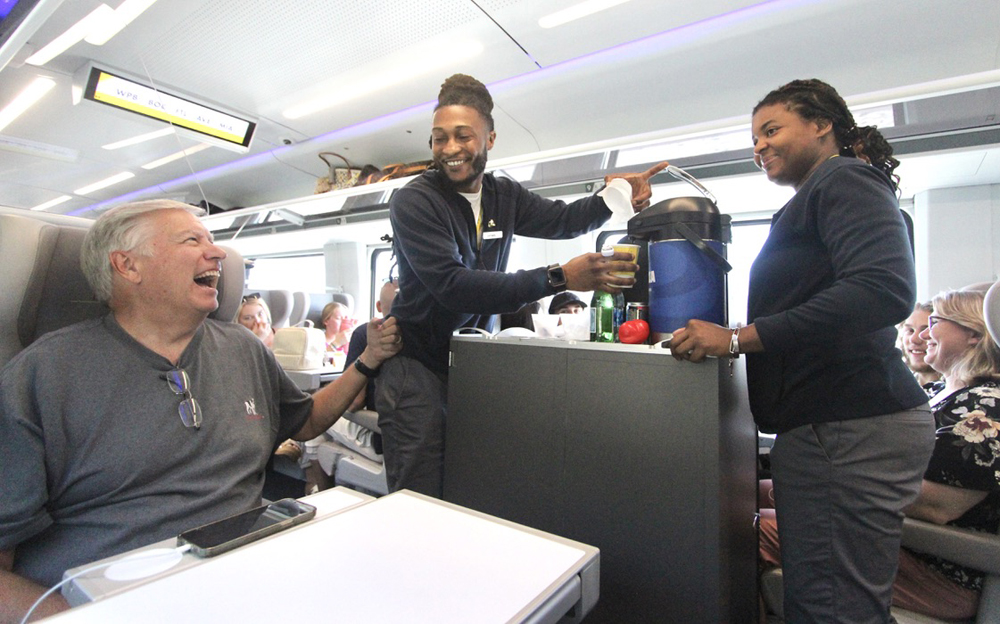
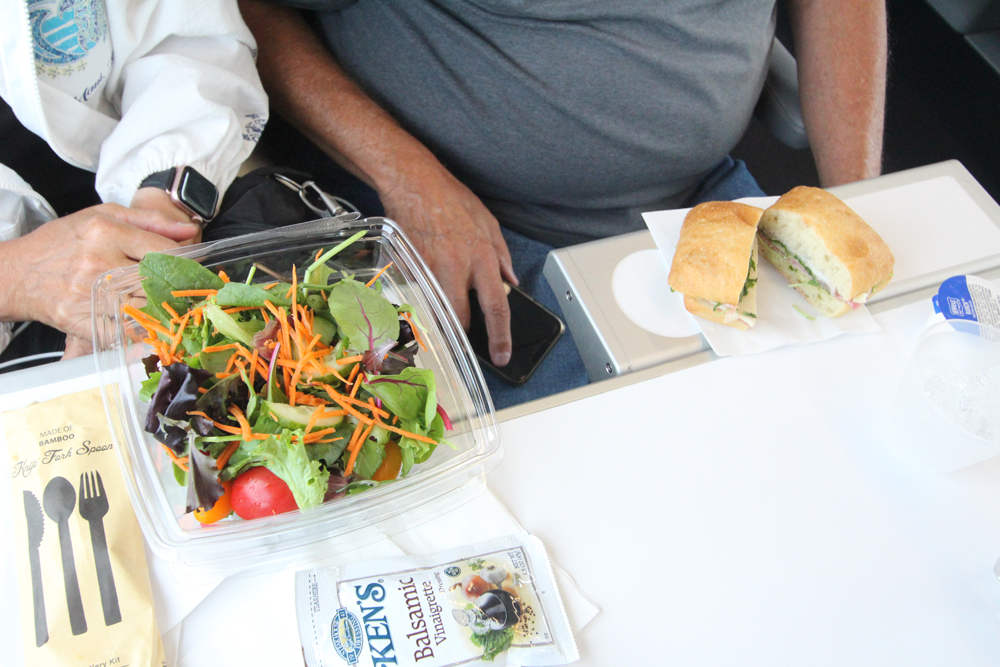
The pricing didn’t seem to faze the Muellers, but only a garden salad and an Italian sandwich were available when Emanual and Lee made their second pass.
The ride got a bit bumpier — but not much — on the Cocoa-to-West Palm segment. This is a brand-new railroad with immaculate ballast and no jolts over freshly minted highway crossings or though crossovers. There was no urge get up and walk around. Maybe that was because with the light-colored interiors, large clean windows, and comfortable seats, the best place to be is right here. Besides, there was plenty to see.
Slowing through Stuart, Fla., at about 40 mph after passing over the St. Lucie River drawbridge, I spotted Luna’s Italian Cuisine. Hmm. More choices than an Italian sandwich. I had the veal scallopini.
— Updated Sept. 26 at 12:25 p.m. CDT to correct spelling of “Borrelli.”
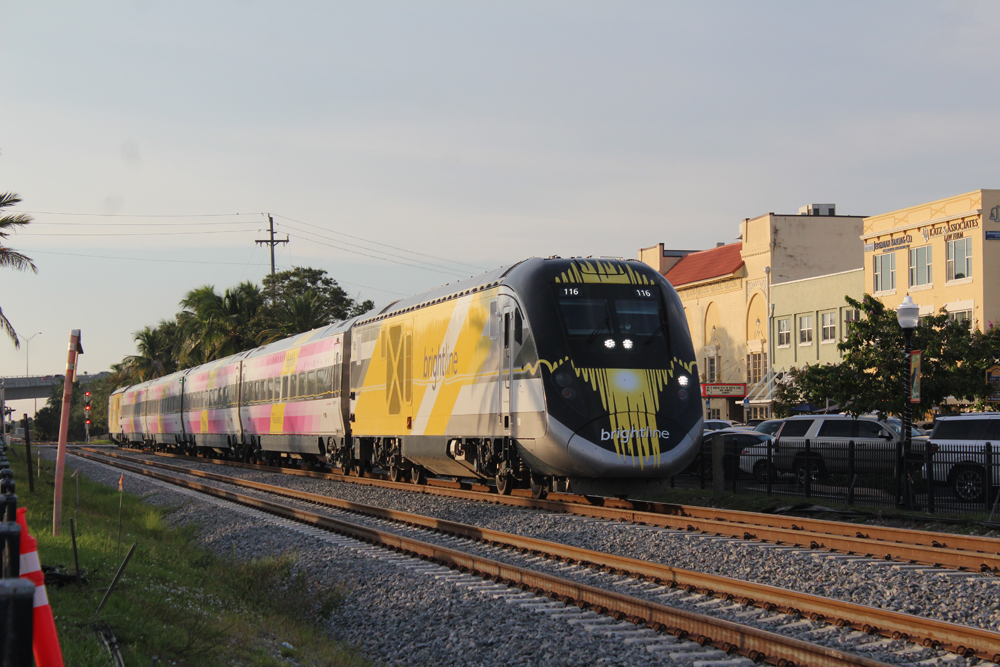








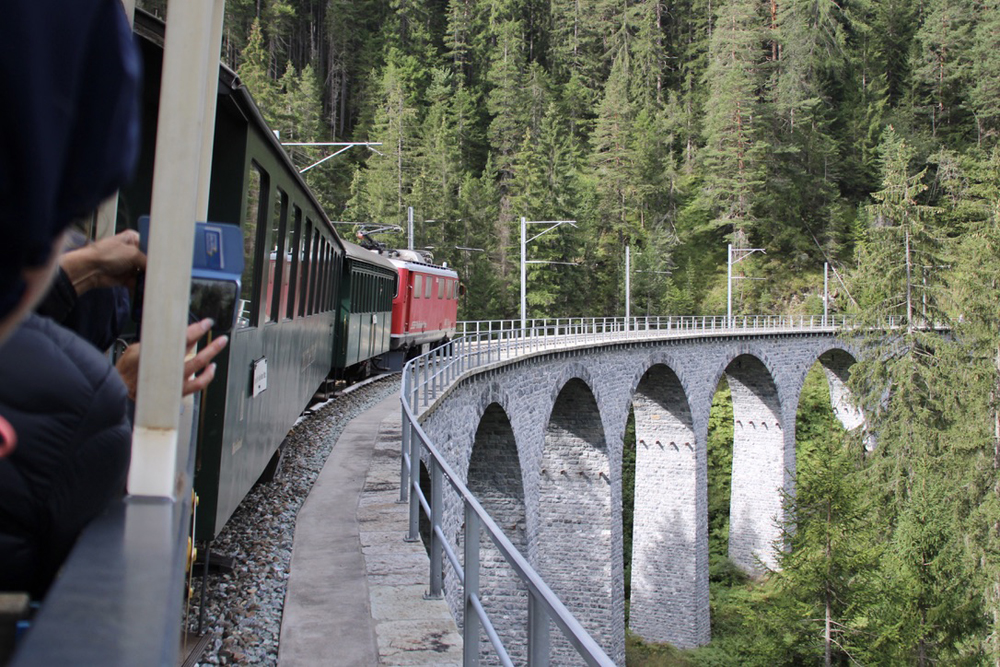




Go Amy – need to hear all voices
Thumbs up Brightline. Take the Amtrak bureaucrats for a ride and show them how to run a passenger train.
I do wonder what is to be done with checked baggage as the service grows. As mentioned the on board baggage area is just a small partition of a regular coach complete with a blacked out window. Telling riders to “just carry it on” is leaving money on the table. Twenty more coaches are coming over the next two years. There were artists renderings of cab cars with a larger door and purpose built baggage area. It may be time to build a coach thus.
The effective Brightline passenger rail formula works like a charm right now. Hoping it always stays like this.
Dr. Güntürk Üstün
When private money and investment undertake a major project like Brightline, things happen and accomplishment and progress are made. If Brightline had to depend on government funding, there wouldn’t be any trains running. A number of years ago when now Senator Rick Scott was the governor of Florida he vetoed and put a stop to any plans or funding for a high speed rail line from Orlando to Miami. Brightline came about through private investment and funding and of course on railroad tracks owned by a privately run railroad the Florida East Coast. I might add as a bit of history that in New York City in the early 20th Century that if it wasn’t for the private transit comapnies such as the Interborough later known as the IRT and the the BRT, New York City’s subway and transit network would never have been built starting in 1904. Of course over 40 years later public ownership and operation of the subway system by the City of New York became a necessity. Even the nation’s railroads being built when this country was growing and being settled in the West was built by private ownership and investment and which led to rapid growth and expansion Say what you want to but without private investment and funding and construction, the railroads would never have been built or play an important role in this nation’s growth. Eventually we might just see Amtrak be reorganized or taken over in some form of private operation and ownership. Brightline is going to give Amtrak some stiff competition for ridership in Florida between Orlando and Miami especially with more frequent service as compared to Amtrak only operating two daily trains each way in Florida and between two very important cities
Joseph C. Markfelder
Brightline is government owned just not our government. They are owned by a ruthless anti_american dictatorship in the middle east. They also completely rely on US tax payer funding through the ability to sell tax free bonds which pay a very high interest rate because the project is so risky. Brightline is a real estate play by the slimmest of all possible players.
Governments can build Intercity and High Speed Rail just fine overseas, it’s not government that can’t build, just government in America.
While I almost always support Mr. Markfelder’s comments, I am pretty sure he inaccurately describes that the railroads were originally built across the country without HUGE government support. The original transcontinental railroads and many other railroads were given huge land grants– certainly the Central Pacific, Union Pacific and Illinois Central (in Illinois) are examples of this. Without them, the railroads would have taken much longer to be built. Additionally the corruption between railroads and state governments is legendary– though forgottten in many states like California– think the Octopus by Upton Sincair (I think); these in effect were huge investments/subsidies.
In any case, both government and business have their strengths and weaknesses. Anything big can be quite efficient but can also get bogged down in bureaucracy.
While I am not a fan of the Emirates (effect on environment, human rights), I would not say they are anti-American; they are pro Emirate and their particular emirate in particular!
Amy: Curious. I understand your point. Could you supply “wealth fund” money compared to U.S. taxpayers money, please.
If the article shows a WELL pleased redership, could it possibly become so profitable as to not depend on tax money?
Certainly if train travel can be so pleasant and excel air travel service, who cares how it got started (again with no taxpayer money) endmrw0925231304
Brightline is owned by a Middle Eastern dictatorship sovereign wealth fund. They do not deserve US tax payer funding.
“owned by a Middle Eastern dictatorship sovereign wealth fund”, and who specifically might that be?
It is more accurate to say that in early 2024, the ownership of Fortress Investment Group, which owns Brightline, will change from SoftBank, a Japanese investment company, to Mubadala, an Emirati state-owned holding company that acts as one of the sovereign wealth funds of the Emirate of Abu Dhabi. Although the acquisition was announced in May 2023, it is not set to close until early 2024.
The Emirate of Abu Dhabi, the owner of Brightline, is an anti-American dictatorship that jails it’s opponents and is helping Russia avoid US sanctions. They should not be celebrated or given our tax dollars.
The hedge fund Fortress is known for forgiving Trump loans and in return Trump allowed them to transport toxic chemicals via rail.
Brightline’s owners are sleazy.
Very impressed from what I see happening with Brightline. I hope to ride it one of these days if I get out to Florida/
“We were supposed to fly from Orlando to Zurich, Switzerland, via a connection in Philadelphia, but American Airlines told us the weather there was horrible and we would likely miss the plane,” Cyndi explained. “They did have two seats on Swissair out of Miami if we could get there, so here we are!
—Exactly how I see Brightline’s value in the future—avoiding airline connection silliness
Another question for those in the know, if I might. What is the current status of plans to bring Amtrak into either Miami Central or the airport station?
Miami Central in downtown will probably never happen. There have been rumblings again of terminating the Silvers at the MIA airport station which is much more desirable than desolate Hialeah. I think that one will happen eventually.
Question for those in the know (I’ve never been to Florida). How is grade crossing compliance (vehicle and pedestrian) along the route? Have there been any incidents?
The world has very little experience of HSR with (to use the British term) level crossings.
Response appreciated.
Brightline has had many many incidents including deaths along the coast where they do run through heavily populated areas. Hopefully people are learning to respect the trains more and such incidents will decline but it’s been a bit of a rough start.
According to Wikipedia, “There have been 88 deaths since Brightline began test runs in 2017, giving it the worst per-mile fatality rate in the nation, according to an ongoing Associated Press analysis that began in 2019.
None of Brightline’s deaths were caused by crew error or faulty equipment, but were all related to suicides or pedestrians and drivers trying to cross and beat the trains, according to law enforcement and federal reports.”
When I was still working there one of my more astute coworkers brought up a map of the ROW and highlighted the halfway houses along the route. It was staggering. The suicide rate will never go down. The drivers in the area seem just as suicidal no matter the road they’re on so not expecting a change there either.
High-speed trains are limited to the same speeds as other (conventional) trains when using grade/level crossings, and are exposed to the same collision risk. When a high-speed train collides with a car, damage to the train is usually only cosmetic. But high-speed trains have also collided with trucks and farm tractors, with more dire results.
Dr. Güntürk Üstün